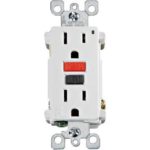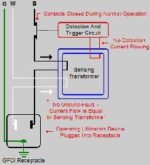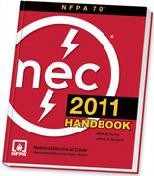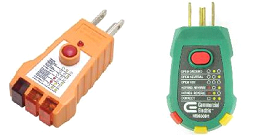 Ground-Fault Circuit Interrupters (GFCIs)
Ground-Fault Circuit Interrupters (GFCIs)
A ground-fault circuit interrupter, or GFCI, is a device used in residential and commercial
buildings that is designed to disconnect a circuit when unbalanced current is detected between an energized wire and a neutral return wire. Such an imbalance is sometimes caused by current “leaking” through a person who is simultaneously in contact with a grounded conductor and an
energized part of a circuit. This condition has the potential to create a lethal shock.
Standard circuit breakers are designed to protect against voltage and current overloads as well as short circuits, but will not trip during a ground fault condition.
QUICK FACT
It is estimated that about 300 deaths by electrocution occur every year. The use of GFCIs has been adopted as a requirement in virtually all new construction, and recommended as an upgrade in older construction in order to mitigate the possibility of injury or fatality from electric shock.
HISTORY OF THE GFCI
The first high-sensitivity system for detecting ground faults was developed by Henri Rubin in 1955 for use in South African mines (no kidding!). His design caused a ground-faulted circuit to de- energize or “trip” before electric shock could drive a person’s heart into ventricular fibrillation, which is usually the specific cause of death attributed to electric shock.
The first transistorized version of the GFCI was developed by Charles Dalziel in 1961. Through the 1970s, most GFCIs were of the circuit-breaker type. This type of GFCI was prone to frequent false trips, especially in circuits with long cable runs. Since the early 1980s, GFCI’S have been built-in to outlet receptacles, and advances in design have improved reliability while reducing instances of “false trips,” also known as “nuisance-tripping”.
 A PRACTICAL EXAMPLE OF A GROUND FAULT IN THE HOME
A PRACTICAL EXAMPLE OF A GROUND FAULT IN THE HOME
Suppose a bare wire inside an appliance (clothes iron, hair dryer, popcorn maker, toaster, etc.)
touches the metal case of the appliance.
The metal case just became charged with electricity!
If you were to touch that appliance with one hand while the other hand is touching a grounded metal object, like a water faucet, you will receive a shock because you just became a conductor for current.
If the appliance is plugged into a GFCI outlet, power will be shut off before a fatal shock would occur.
The GFCI interrupts the current flow before it can hurt you!
 BASIC OPERATION OF THE GFCI
BASIC OPERATION OF THE GFCI
The operation of a GFCI is really quite simple. It compares the amount of current going out to the load (lamp, hair dryer, microwave oven, etc.) and the amount of current returning from that load.
It uses a Current Transformer Circuit (CT) to compare the difference between these current amounts.
If the current going out to the load equals the current coming back, there is no “leakage to ground” (Ground Fault), the output from the Current Transformer Circuit is zero, and everything’s fine.
If there is an imbalance in current (ground fault), the CT circuit will determine if the fault is sufficient to necessitate the interruption of the current flow (Hence the name Ground Fault Circuit Interrupter). SIMPLE!
 GFCI’S AND THE NATIONAL ELECTRICAL CODE (NEC)
GFCI’S AND THE NATIONAL ELECTRICAL CODE (NEC)
The National Electrical Code (NEC) has included recommendations and requirements for GFCIs in some form since 1968, when it first allowed for GFCIs as a method of protection for underwater
swimming pool lights.
Throughout the 1970s, GFCI installation recommendations were gradually added for 120-volt receptacles in areas prone to possible water contact, including bathrooms, garages, and any receptacles located outdoors.
The 2011 NEC is the most up to date code source and contains additional updates relevant to GFCI use, as well as some exceptions for certain areas.
As always, your AccuTech Professional will be able to answer any specific questions that arise with regards to NEC requirements and recommendations.
TESTING OF RECEPTACLE-TYPE GFCI’S
Receptacle-type GFCIs are currently designed to allow for safe and easy testing by a property owner without the need for any professional or technical knowledge of electricity.
GFCIs should be tested once a month to make sure they are working properly and are still providing protection. The first method below does not required specialized “tester” to perform. The second method requires the use of a UL approved GFCI circuit tester that can be purchased for about $10-$15 and any hardware store.
IMPORTANT SAFETY NOTE: IF YOU DON’T FEEL COMFORATBLE TESTING YOUR GFCI OUTLETS, CALL A PROFESSIONAL!!!
To test a receptacle GFCI without a specialized GFCI Tester:
• Ensure that the outlet is functioning by plugging in a nightlight or other small appliance into the outlet (with the appliance OFF). Turn the appliance ON. The appliance should operate normally.
• Press the “TEST” button on the GFCI outlet. The “RESET” button should pop out with an audible click, and the light / appliance should turn off.
• If the “RESET” button pops out but the appliance does not turn off, the GFCI has been improperly wired. Contact a licensed, certified electrical specialist to correct the wiring error(s).
• If the “RESET” button does not pop out, and the appliance remains powered, the GFCI is defective and should be replaced.
• If the GFCI is functioning properly and the appliance turns off, turn off and disconnect the appliance, press the “RESET” button to restore power to the outlet, and re-connect the
appliance is desired.
To test a receptacle GFCI using a UL Approved GFCI Tester:
 • All UL approved testers come with brief instructions. Read the instructions first!
• All UL approved testers come with brief instructions. Read the instructions first!
• Insert the GFCI test plug into the powered outlet. All UL-Approved testers have a small “Indicator Light Matrix” that describes each light condition when testing (see photos at right).
• The lights corresponding to a NORMAL condition should be illuminated if the outlet is powered and wired correctly.
• If any other light configuration other than NORMAL is illuminated, the outlet is incorrectly wired and an electrical specialist should be contacted to correct the defect.
• Press the TEST button on the tester. All lights on the tester should go out and the
RESET button on the outlet should pop out, indicating that a simulated ground fault condition has occurred. If this does not occur, the outlet is defective and should be replaced.
GFCI outlets are simple and cost-effective safety devices that help to prevent electrical shock hazards in a home or building. As Industry Professionals, a basic understanding of their purpose and operation is helpful.